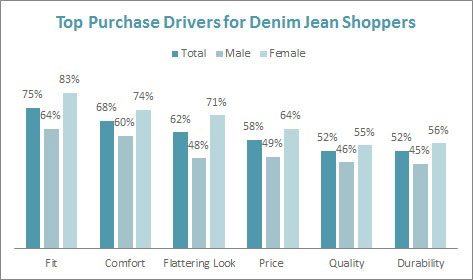With the Kingpins Show and Texworld wrapping up this week, those in the denim industry got a chance to see the next evolution of treatments and techniques. The options are many. And while novelty finishes and new coatings are vital for generating buzz and interest, consumers still seem more concerned with finding the perfect fit.
[quote]At the Denim Saloon in Omaha, NE, the spring/summer season will usher in some tweaks to proven customer favorites, says Jenny Galley, co-owner.
“Boyfriend and skinny jeans continue to be our bestsellers for women and we expect that to continue through spring,” she says. “Straight legs sell well in spring as well, because they pair well with flats. And in men’s, guys are going toward slim straight, whereas straight classic was the best seller.”
Finding a jean that fits is consistently the chief concern for consumers. In fact, 75% of shoppers list “fit” as the top feature they seek in their jeans, according to the Cotton Incorporated Lifestyle Monitor™ Survey, followed by comfort (68%), comfort a flattering look (62%), price (58%), and quality (52%).
For the ultimate in fit, some shoppers are turning to bespoke denim, from places like 3×1 on Manhattan’s trendy Mercer Street, to Levi’s in San Francisco, where a tailor will fit made-to-measure Lot No. 1 jeans.
While custom denim is a great option for higher income shoppers, most consumers find themselves trying on pair after pair in their search for a great fitting jean they can also afford. Lately, some consumers have had another difficulty with their search — “great fitting” jeans that lose their shape due to poor stretch recovery.
As a result, many of these shoppers have taken their complaints online on brand and retail comment boards. The Cotton Incorporated Customer Comments Research™ project conducted an analysis of more than 300,000 shopper comments available on 25 key retailer websites for over 35,000 apparel and home textile products. The top complaint among women regarding denim performance involved stretch recovery (28%).
“I’m thinking of writing a real letter on paper to express my disappointment in these jeans,” wrote one specialty store customer. “I washed and dried them as directed, put them on feeling really good, and within an hour they had stretched out to ridiculous proportions. …They were huge and baggy and I felt like a rodeo clown.”
Another customer who spent $59 on women’s denim at a specialty store warned customers of her issue with a certain blended jean.
“Bought these jeans because they fit great and the color was perfect for casual days at work. However, within just a few minutes of wearing them, they were unbelievably stretched out. I mean they are a full size larger than when you first put them on. I literally cannot keep them from slipping down. A belt is not an option because the whole jean is big, legs, booty, everything. I was hoping that after I washed them, they would shrink a bit and be ok, but same problem again. I put them on, fit fine for first few minutes, then STRETCH! Would not recommend these.”
DenimHunt’s Shanna McKinnon, the blog’s editor, says some manufacturers are taking stretch and fiber substitution too far.
“When brands first started adding stretch, they were using nearly 100% cotton and adding some give,” McKinnon says. “But now, some brands use hardly any cotton, and it doesn’t feel like denim. When you’re getting to the point where it’s a legging with an indigo finish, it’s not a jean.
“Denim has been around for a long time for a reason — it lasts forever, ” McKinnon continues. “People have a relationship with their jeans, but you can’t do that when you want to throw it away or take it back after you wear it a couple of times.”

The Monitor survey found 61% of U.S. consumers are dissatisfied with fiber substitutions in denim jeans, an apparel item that traditionally contained high levels of cotton. Besides stretch, shoppers were also dissatisfied with odor, wear and tear, wrinkling, and snagging.
Such discontent with a purchase can ultimately impact the retailer’s bottom line. About two-thirds (65%) of consumers say they are “very or somewhat likely” to refrain from purchasing an apparel item because the product reviews were negative.
Perhaps partially as a result, denim has lost market share in the U.S., decreasing from 37% of the bottomswear offerings at retail in 2011 to 31% in 2013, according to the Cotton Incorporated Retail Monitor™ Survey.
Galley says there are a lot of brands that contain high percentages of stretch, but the Denim Saloon tends to sell more of a traditional jean with a little give.
“And we still get requests for non-stretch denim,” she adds.
Some other Denim Saloon customer requests include gray and distressed jeans (although brightly colored denim is decreasing in popularity), timeless denim jackets, and skirts that hit mid-knee.
Looking forward, McKinnon says shoppers should expect to see light sky blue denim reminiscent of the ’90s.
“It’s really bleached out, almost white denim and I’m seeing it in the skinny silhouette,” she says. “But there are also neon brights and more traditional florals like ’80s chintz. For fall, the denim is more distressed and darker with some rips, tears and more coatings, sometimes with a laser burnout or color underneath. In a couple of years you might see simpler, darker jeans. But right now, denim is the center of the wardrobe and we’re still seeing that almost anything goes.”
